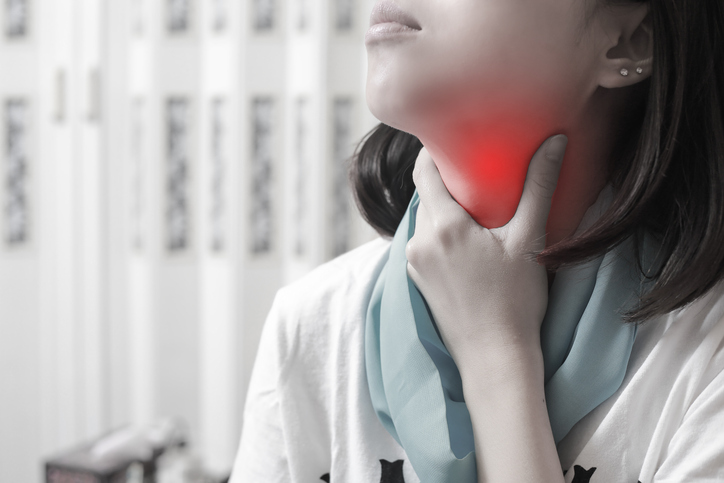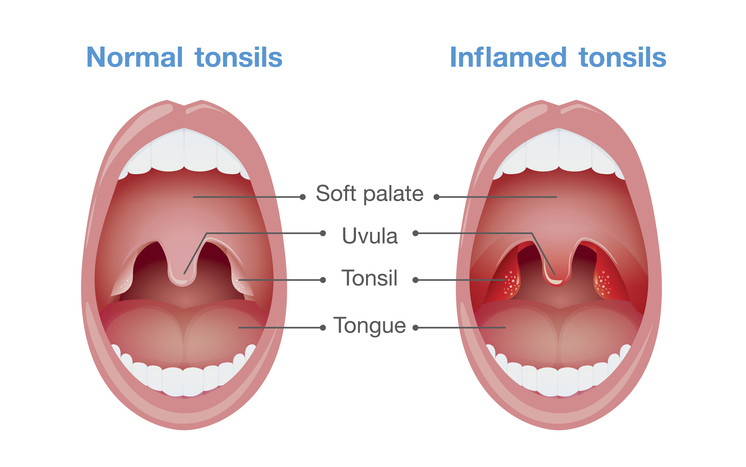
Many people visit ambulatory care for their “pain in the throat.” Their complaints vary from “difficulty in swallowing liquid” to “sleeplessness due to a soreness in the throat” and so on. Findings on physical examinations also vary: sometimes a throat may not look as red as complained, and other times it may get severely swollen with pus.
Different approaches should be taken for a sore throat depending on causes and conditions. A general practitioner Dr. Yoshiya Hasegawa will offer some insights into how to diagnose, its causes and seven effective/valuable ways to deal with a sore throat.
Contents
1.Why does one develop a sore throat?

Here are the most common causes for a sore throat.
First, what causes a sore throat? Our throat has a function in preventing foreign invaders from entering our bodies with air and food passing down the throat. The throat that is protected by mucous membranes becomes inflamed when the body’s defense mechanism is triggered when viruses or bacteria damage and injure the throat. The inflamed areas then become red, hot, swollen, and cause pain.
Cells attacked by foreign invaders discharge chemical substances. The discharged chemical substances expand blood vessels in order to gather leukocytes which fight against foreign invaders. It increases blood volume, and blood components exit from capillaries and stay there with lymph fluid. This is “swelling.” It develops a pain when this swollen part stimulates nerves around it. This inflammation in the throat causes “a sore throat.”
2. Causes for a sore throat
There are various causes for a sore throat.
2-1. Cold and tonsillitis
When you have a cold or tonsillitis and viruses or bacteria enter mucous membranes inside the mouth, they cause inflammation in the throat or tonsil.

Inflamed areas caused by tonsillitis
2-2.Overuse of the throat
If you continuously yell or sing for long periods of time, it may cause inflammation in the throat.
2-3.Influence of alcohol
Have you experienced a sore throat after drinking too much alcohol and suspected that you caught a cold? Breaking down alcohol requires a lot of water and it dehydrates cells. Consequently, it dries the throat and causes inflammation. In another case, alcohol directly damages mucous membranes so that you may start to develop pain or a hoarse voice.
2-4.Influence of smoking
Exposure to cigarette smoke containing harmful substances directly generates a negative effect to the throat and leads to inflammation in the vocal cords.
2-5.Dry Air
Mucous membranes in the throat prevent entry of foreign invaders when the throat is sufficiently moist. However, when the throat is too dry, these foreign invaders can easily attack which possibly leads to an inflammation. The appropriate humidity for the throat is about 60 percent. In an air-conditioned room in summer time, it is about 40 to 50 percent of humidity, while 20 percent in winter. Therefore, it is necessary to keep the air as moist as possible.
2-6.Allergic symptoms
Many patients who develop a pollen allergy complain of a “sore throat.” However, it can be said to be a “throat irritation” rather than a “sore throat.” The treatment in this case should be to use an anti-allergic agent to treat the original cause.
3.Approaches
You can relieve the pain in the throat by trying following tips.
3-1.Humidification
A pain will be relieved when you add moisture to the room air and keep the appropriate level of humidity. It also will be relieved by wearing a mask because it gives some moisture to the throat. Viruses and such get inside through the mesh of a mask. On this understanding we, health care providers, wear masks to prevent a throat from getting dry rather than to defend against infection.
To suck on a cough drop or a lozenge which adds some moisture to a throat, is an effective way to keep a throat moistened and eases pain. There are various types of drops/lozenges sold as drugs, quasi-drugs and foods. However, the effectiveness is relatively equal because they add some moisture to a throat.
3-2.Disinfection
It is effective to disinfect a throat by gargling, applying or spraying mouthwash. Medical institutions commonly prescribe mouthwash called “Isodine.” Povidone-Iodine contained in Isodine isolates iodine and disinfects rapidly and effectively a wide range of microbes such as bacteria, fungi, and viruses.
You can find various types of products with Povidone-Iodine such as sprays, mouthwash, and lozenges at drug stores.
3-3.Antipyretic analgesics
One of the common treatments used by medical practitioners is prescribing antipyretic analgesics. Antipyretic analgesics reduce inflammation and pain as well as work well for fever and headache. It reduces inflammation symptomatically, but it does not treat definitively. As part of our body’s natural process of healing, the human body causes irritation and pain in the throat.
Use of antipyretic analgesics sometimes slow down their recovery. I personally do not prescribe antipyretic analgesics for a sore throat unless it is absolutely necessary. Of course, sufficient explanation has to be provided to the patients in any case.
3-4.Antibiotics
Apply antibiotics if there is pus in the throat and if it is suspected to arise from bacterial infection. Antibiotics treatment is unnecessary for a common flu, however aggressive usage of antibiotics is preferred if it is a bacterial infection.

It is very popular to take consume a drink with honey, lemon or ginger when we get a cold. It may have an effect onto relieving cold symptoms even though there is no evidence for the its effects to on a pain in a throat.
4.How to determine white pus in the throat
If you find something like milk crumbs when you see it in the back of your throat with a mirror, you might have developed pus. Sometimes you might feel soreness due to the pus in the throat, but other times you might feel nothing.
4-1.When you feel a pain in the throat
When you have a pain or a fever, it is suspected to be of bacterial infection. In such case, testing for group A streptococcus, or group A strep, is necessary. Medical practitioners can easily carry out an in-clinic diagnostic test by using a diagnosis kit. When group A strep pharyngitis is left untreated, acute rheumatic fever which causes heart valve disease or complications such as poststreptococcal acute glomerulonephritis are more likely to occur. This group A strep pharyngitis is most common among children, but adults are also at risk of this disease and need to be examined. Clear explanations must be given since a prolonged use of antibiotics (for 10 – 14 days) is required to treat group A strep pharyngitis.
Even though group A strep infection might be negative, if a result of the blood test indicated an inflammatory response by an increase of CRP or the number of leukocytes, apply or give a drip of antibiotics to treat bacterial infection. Tonsillectomy could be considered for adults who repeatedly get a fever higher than 38 degrees due to strep pharyngitis several times a year.

Inflammation develops extensively in the throat
4-2. When you do not have a pain in the throat
If you see white pus in the throat and feel no pain at all, it may be a “tonsil stone/tonsillolith.” You see a tonsil on each side in the back of your throat when you open your mouth. Tonsils have a pit where dead bacteria are more likely to be trapped when you have an inflammation in your tonsils. This debris is called tonsil stones or tonsillolith.
Tonsil stones develop due to an inflamed tonsil, but no particular treatment is necessary if no symptoms are caused. If you feel a foreign sensation or discomfort in the throat, tonsil stones may be removed by some of these methods: applying pressure until it pops out, dislodging with a suction instrument or a tweezer, or washing out with diluted saline solution at the otorhinolaryngology clinics.
5. Is it effective applying Lugol solution to the throat?
My mother used to apply antiseptic solution called Lugol solution in the back of the throat when I caught a cold. It alleviated cold symptoms though it burned my throat right after applying. It seems that physicians currently are less likely to apply Lugol solution. Oropharynx can be seen when a mouth is open, and this is located lower than epipharynx. Many physicians think applying a medicine to oropharynx makes no sense.
However, otorhinolaryngologists know it works very well on inflamed epipharynx. This treatment is highly regarded among otorhinolaryngologists as Epipharyngeal Abrasive Therapy (EAT), known as “B-spot therapy”. B-spot therapy or EAT is a treatment to apply an antiphlogistic agent to epipharynx which is located behind palatine uvula in the back of the nose. It is somewhat painful, but the symptom gets better after application. My mother applied Lugol solution far back in the throat while I was lying and making a sound with my voice. So I, not otorhinolaryngologist but a physician, believed this treatment works well on a sore throat.
6. Preventive actions for a sore throat
Here is a list of preventions for a sore throat.
6-1. Strengthen your immune system and avoid pathogen getting in your body
Always try to lead a regular life because sore throats and colds can sneak up when you bar hop until late at night. In other words, leading a regular lifestyle with regular sleep-wake rhythm, healthy foods, and some exercise will make your immune system stronger.
6-2. Take good care of your throat by hydrating it
Constant care should be taken for dryness regardless of season. Proper use of humidifiers or wearing a mask are effective to prevent from being dry. Also, you should take water to add some moisture to your body.
6-3. When you feel discomfort in your throat
Even though you might be taking good care of your condition, there is a possibility of catching a cold and feel a pain in your throat. I personally take Kakkonto or Pueraria Decoction, an herbal medicine, and apply isodine to the back of the throat with a cotton swab at this stage. This helps in preventing the condition from getting worse. Try these remedies to help you feel better.
7. Summary
- Sore throat is triggered from various causes.
- Antibiotics are to be prescribed by a medical institution when you have pus in the throat and have a pain or fever.
- When you are coming down with a cold and having a sore throat, home remedies I suggest are taking Kakkonto or Pueraria Decoction and disinfection of the throat.

